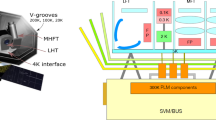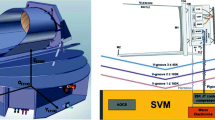Abstract
General principles are outlined for the design of space infrared telescopes intended to cool by radiation to the lowest temperatures attainable without the use of on-board cryogens, and assuming on-orbit cooling after a warm launch. Maximum protection from solar and earth heating, maximum radiating area and efficiency and minimum absorbing area and absorptivity are the obvious basic criteria. The optimised design is a short, fat telescope surrounded by a series of radiation shields, each cooled by its own radiator. Maximising the longitudinal conductivity of the radiation shields and of the telescope tube itself is important both to the on-orbit cooling time and the final achieveable temperature. Realistic designs take between 80 and 200 days to cool to within a few degrees of equilibrium temperatures, depending on the materials used. Great advantages accrue from the use of an orbit distant from earth. Both simple models and detailed simulations suggest that temperatures of 30 to 40 K are attainable in high earth orbits. Placing a radiatively cooled telescope in a halo orbit around the Lagrangian point L2 is a particularly attractive option and significantly lower temperatures can be achieved there than in Earth orbit. Optimised radiative cooling is an important element of the small Japanese mission SMIRT. We suggest that a combination of an ESA Medium-sized Mission with a NASA Explorer to send a 2m+ telescope to an L2 halo orbit would provide a cost-effective and powerful long-duration facility for the early 21st century.
Similar content being viewed by others
References
Bramson, M.A.: 1968, Infrared Radiation, a Handbook for Applications, trans. Rodman, R.B., ed. Wolfe, W.L., Plenum, NY
Davidson, A. M., Seidel, A. and Wanner, M.: 1989, ESA Bulletin 57, 53
Davies, J. K., Hawarden, T. G. and Mountain, C. M.: 1991, Acta Astronautica 25, 223
Emery, R. J.and Burgio, C.: 1982, Infrared Space Observatory: Report on the Phase A Study, ESA SCI(82)6
Gautier, T.N., Boulanger, F., Pérault, M. and Puget, J-L.: 1992, Astron. J. 103, 1313
Helou, G. and Beichman, C. A.: 1990, Proc. 29th Liege Intl. Astrophys. Colloq.
Hust, J. G.: 1983, in R. P. Reed and A. F. Clark, ed(s)., Materials at low temperatures, American Society for Metals/National Bureau of Standards, 133
LaRocca, A.J.: 1978, in W.L. Wolfe and G.J. Zissis, ed(s)., Infrared Handbook (2nd ed.), US Govt. Printing Office,
Lee, J. H.: 1990, Cryogenics 30, 166
Loftus, J. P., Texeira, C. and France, M. E. B.: 1991, in J. R. Wertz and J. L. Wiley, ed(s)., Space Mission Analysis and Design, Kluwer, 607
Mason, P. V.: 1988, Cryogenics 28, 137
McMordie, R. K.: 1991, in J. R. Wertz and J. L. Wiley, ed(s)., Space Mission Analysis and Design, Kluwer, 370
Orlowska, A. H., Bradshaw, T. W. and Hieatt, J.: 1990, Cryogenics 30, 246
Sparks, L. L.: 1983, in R. P. Reed and A. F. Clark, ed(s)., Materials at low temperatures, American Society for Metals/National Bureau of Standards, 47
Thronson, H. A., Jr., Davies, J. K., Hackwell, J., Hawarden, T. G., Knacke, R. F., Lester, D. F. and Mountain, C. M.: 1993, Space Science Reviews, this volume
Williamson, M.: 1987, Phys. Technol. 18, 120
Author information
Authors and Affiliations
Rights and permissions
About this article
Cite this article
Hawarden, T.G., Cummings, R.O., Telesco, C.M. et al. Optimised radiative cooling of infrared space telescopes and applications to possible missions. Space Sci Rev 61, 113–144 (1992). https://doi.org/10.1007/BF00212480
Issue Date:
DOI: https://doi.org/10.1007/BF00212480




